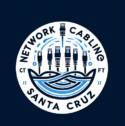Where Do Most Problems Occur in a Cabling System?
A well-designed cabling system is the backbone of every reliable network, whether in an office, warehouse, or smart home. But even the best systems can run into issues if they aren’t installed or maintained properly. Understanding where most problems occur in a cabling system helps prevent costly downtime, slow internet speeds, and frequent connection drops.
Let’s explore the most common weak points in cabling systems — and how to fix or avoid them. Our Santa Cruz cabling experts ensure every system is installed and maintained to prevent the common issues that lead to downtime.
1. Poor Cable Terminations
One of the top causes of network failure is improper cable termination. This happens when cables aren’t correctly connected to jacks, patch panels, or connectors.
Bad terminations lead to:
- Signal loss and intermittent connectivity
- Cross-talk between wires
- Reduced data transmission speeds
Always ensure cables are terminated according to ANSI/TIA-568 standards using quality connectors and properly calibrated tools. Professional installers use cable testers to verify every connection before final sign-off.
2. Excessive Cable Bends or Tension
Another common issue is bending or pulling cables too tightly during installation. Each cable type — especially CAT6 or fiber optic — has a specific bend radius. If exceeded, internal conductors can break or signals can weaken.
To prevent damage:
- Follow manufacturer guidelines for bend radius and pulling tension
- Use cable management trays or conduits
- Avoid sharp corners or tight cable bundles
A little care during installation can save hours of troubleshooting later.
3. Electromagnetic Interference (EMI) and Crosstalk
When data cables run too close to electrical wiring, fluorescent lights, or motors, they can pick up electromagnetic interference (EMI). This interference disrupts signal transmission and causes unstable network performance.
Common solutions include:
- Keeping network cables at least 12 inches away from power lines
- Using shielded twisted-pair (STP) or CAT6a shielded cables in high-EMI environments
- Proper grounding and separation in cable trays
Shielding and spacing are simple yet effective ways to maintain a clean signal.
4. Poor Cable Management and Labeling
A tangled mess of cables may look harmless, but it’s one of the biggest causes of maintenance headaches. Without proper cable management, tracing faults becomes difficult and increases the risk of unplugging the wrong connection.
Best practices include:
- Label every cable at both ends
- Use Velcro ties instead of zip ties to prevent crushing
- Group cables by type and function
- Maintain detailed documentation of all connections
Organized cabling isn’t just neat — it’s essential for fast troubleshooting and future upgrades.
5. Using Low-Quality or Incompatible Materials
Not all cables are created equal. Using cheap or uncertified materials often leads to poor performance, especially over longer runs. Substandard cables may fail to meet bandwidth requirements, degrade quickly, or violate California’s building and fire codes.
Always choose cables rated for your application (such as CAT6 or CAT6a for Gigabit networks) and confirm they are UL-listed or ETL-verified. Investing in quality materials pays off with years of dependable performance.
6. Environmental Factors
Environmental conditions can also cause cable issues. Extreme temperatures, humidity, dust, or rodents can all impact performance.
To protect your network:
- Use plenum-rated cables in areas with air circulation
- Choose outdoor-rated or UV-resistant cables for exterior runs
- Keep cables in conduit where possible
- Inspect regularly for wear, corrosion, or pest damage
Proactive maintenance helps avoid network interruptions caused by environmental stress.
7. Inadequate Testing and Certification
Even after a successful installation, skipping the testing phase can hide underlying problems. Every structured cabling project should be tested for performance, continuity, and compliance with industry standards.
Certified installers use advanced testers to measure:
- Signal loss (attenuation)
- Return loss
- NEXT (Near-End Crosstalk)
- Wire map accuracy
Proper testing ensures your system is ready for high-speed performance — and helps you catch small issues before they become big ones.
8. Human Error and Improper Handling
Many cable problems stem from simple human mistakes — unplugging the wrong cable, patching into the wrong port, or stepping on exposed lines.
Training your IT or maintenance staff on proper handling procedures helps reduce these issues. Combine that with clear documentation and color-coded cabling, and you’ll drastically cut down on accidental errors. Exposure to moisture can also lead to serious performance issues — learn more about whether LAN cables are waterproof and how to protect them from damage.
Keeping Your Cabling System Reliable
Most cabling issues can be prevented with proper design, installation, and maintenance. The key is to follow standards, use quality materials, and hire experienced professionals who understand both the technical and regulatory requirements of network cabling.
Regular inspections and testing also go a long way in ensuring your network stays fast, clean, and dependable for years to come.
If you’re experiencing connectivity problems or planning an upgrade, consult a licensed cabling contractor in California to evaluate your current system and recommend improvements.
